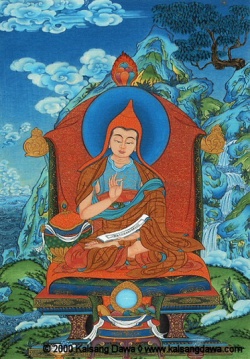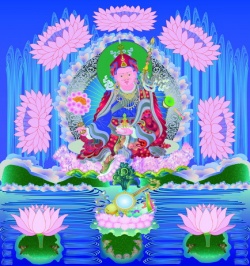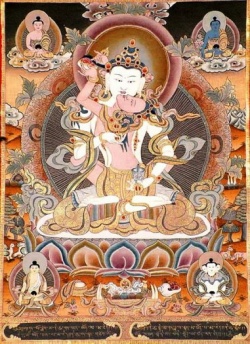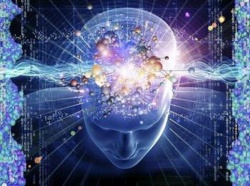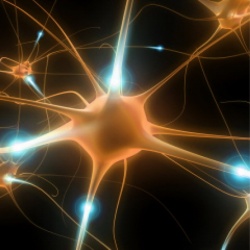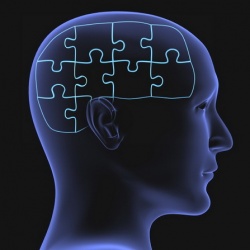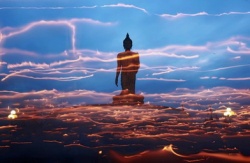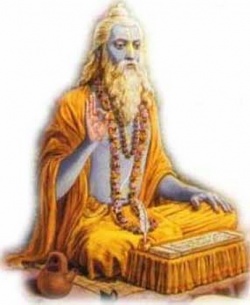Difference between revisions of "Vijñāna"
m (Text replacement - "Category:Pali terminology" to "{{PaliTerminology}}") |
|||
| Line 16: | Line 16: | ||
:(1) as a derivative of the [[sense]] bases (''[[āyatana]]''), part of the experientially exhaustive "All" (''[[sabba]]''); | :(1) as a derivative of the [[sense]] bases (''[[āyatana]]''), part of the experientially exhaustive "All" (''[[sabba]]''); | ||
:(2) as one of the [[five aggregates]] (''[[khandha]]'') of [[clinging]] (''[[Upadana]]'') at the [[root]] of [[Suffering]] (''[[Dukkha]]''); and, | :(2) as one of the [[five aggregates]] (''[[khandha]]'') of [[clinging]] (''[[Upadana]]'') at the [[root]] of [[Suffering]] (''[[Dukkha]]''); and, | ||
| − | :(3) as one of the twelve [[causes]] (''[[Twelve Nidanas|nidana]]'') of "[[Dependent origination]]" (''[[Pratitya-samutpada|paticcasamuppāda]]'') which provides a template for [[Buddhist]] notions of [[Karma|kamma]], [[rebirth]] and release. | + | :(3) as one of the twelve [[causes]] (''[[Twelve Nidanas|nidana]]'') of "[[Dependent origination]]" (''[[Pratitya-samutpada|paticcasamuppāda]]'') which provides a template for [[Buddhist]] notions of [[Karma|kamma]], [[rebirth]] and [[release]]. |
In the [[Pali Canon]]'s [[Abhidhamma]] and in post-{{Wiki|canonical}} [[Atthakatha|Pali commentaries]], [[consciousness]] (''[[Viññāṇa]]'') is further analyzed into 89 different states which are categorized in accordance with their [[karma|kammic]] results. | In the [[Pali Canon]]'s [[Abhidhamma]] and in post-{{Wiki|canonical}} [[Atthakatha|Pali commentaries]], [[consciousness]] (''[[Viññāṇa]]'') is further analyzed into 89 different states which are categorized in accordance with their [[karma|kammic]] results. | ||
| Line 28: | Line 28: | ||
In this context, for instance, when an ear's receptive field (the {{Wiki|proximal stimulus}}, more commonly known by [[Buddhists]] as a [[Sense base]], or [[sense]] {{Wiki|organ}}) and [[sound]] (the distal {{Wiki|stimulus}}, or [[sense]] [[object]]) are {{Wiki|present}}, the associated (ear-related [[consciousness]]) arises. The [[arising]] of these three [[elements]] ([[dhātu]]) – e.g. {{Wiki|ear}}, [[sound]] and [[ear-consciousness]] – lead to the {{Wiki|percept}}, known as "[[contact]]" and in turn [[causes]] a [[pleasant]] or [[unpleasant]] or [[neutral]] "[[feeling]]" to arise. It is from such a [[feeling]] that "[[craving]]" arises. (See Fig. 1.) | In this context, for instance, when an ear's receptive field (the {{Wiki|proximal stimulus}}, more commonly known by [[Buddhists]] as a [[Sense base]], or [[sense]] {{Wiki|organ}}) and [[sound]] (the distal {{Wiki|stimulus}}, or [[sense]] [[object]]) are {{Wiki|present}}, the associated (ear-related [[consciousness]]) arises. The [[arising]] of these three [[elements]] ([[dhātu]]) – e.g. {{Wiki|ear}}, [[sound]] and [[ear-consciousness]] – lead to the {{Wiki|percept}}, known as "[[contact]]" and in turn [[causes]] a [[pleasant]] or [[unpleasant]] or [[neutral]] "[[feeling]]" to arise. It is from such a [[feeling]] that "[[craving]]" arises. (See Fig. 1.) | ||
| − | In a {{Wiki|discourse}} entitled, "The All" ([[Sabba Sutta]], SN 35.23), The [[Buddha]] states that there is no "all" outside of the six pairs of [[sense]] bases (that is, six internal and six external [[sense]] bases). The "To Be Abandoned {{Wiki|Discourse}}" ([[Pahanaya Sutta]], SN 35.24) further expands the All to include first five aforementioned sextets (internal [[sense]] bases, external [[sense]] bases, [[consciousness]], [[contact]] and [[feeling]]). In the famed "[[Fire]] {{Wiki|Sermon}}" ([[Ādittapariyāya Sutta]], SN 35.28) The [[Buddha]] declares that "the All is aflame" with [[passion]], [[aversion]], [[delusion]] and [[Suffering]] ([[Dukkha]]); to obtain release from this [[Suffering]], one should become disenchanted with the All. | + | In a {{Wiki|discourse}} entitled, "The All" ([[Sabba Sutta]], SN 35.23), The [[Buddha]] states that there is no "all" outside of the six pairs of [[sense]] bases (that is, six internal and six external [[sense]] bases). The "To Be Abandoned {{Wiki|Discourse}}" ([[Pahanaya Sutta]], SN 35.24) further expands the All to include first five aforementioned sextets (internal [[sense]] bases, external [[sense]] bases, [[consciousness]], [[contact]] and [[feeling]]). In the famed "[[Fire]] {{Wiki|Sermon}}" ([[Ādittapariyāya Sutta]], SN 35.28) The [[Buddha]] declares that "the All is aflame" with [[passion]], [[aversion]], [[delusion]] and [[Suffering]] ([[Dukkha]]); to obtain [[release]] from this [[Suffering]], one should become disenchanted with the All. |
Hence, in this context, [[Viññāṇa]] includes the following {{Wiki|characteristics}}: | Hence, in this context, [[Viññāṇa]] includes the following {{Wiki|characteristics}}: | ||
| Line 51: | Line 51: | ||
" "And why do you call it '[[perception]]'? Because it [[perceives]], thus it is called '[[perception]].' What does it {{Wiki|perceive}}? It [[perceives]] blue, it [[perceives]] yellow, it [[perceives]] red, it [[perceives]] white. Because it [[perceives]], it is called [[perception]]." | " "And why do you call it '[[perception]]'? Because it [[perceives]], thus it is called '[[perception]].' What does it {{Wiki|perceive}}? It [[perceives]] blue, it [[perceives]] yellow, it [[perceives]] red, it [[perceives]] white. Because it [[perceives]], it is called [[perception]]." | ||
| − | Similarly, in the [[traditionally]] venerated 5th c. CE commentary, the [[Visuddhimagga]], there is an extended analogy about a child, an adult villager and an expert "[[money]]-changer" [[seeing]] a heap of coins; in this analogy, the child's [[experience]] is likened to [[perception]], the villager's [[experience]] to [[consciousness]], and the [[money]]-changer's [[experience]] to true [[understanding]] (paňňā). Thus, in this context, "[[consciousness]]" denotes more than the irreducible subjective [[experience]] of [[sense]] {{Wiki|data}} suggested in the discourses of "the All" (see prior section); here, "[[consciousness]]" additionally entails a depth of [[awareness]] reflecting a {{Wiki|degree}} of [[memory]] and [[recognition]]. | + | Similarly, in the [[traditionally]] venerated 5th c. CE commentary, the [[Visuddhimagga]], there is an extended analogy about a child, an adult villager and an expert "[[money]]-changer" [[seeing]] a heap of coins; in this analogy, the child's [[experience]] is likened to [[perception]], the villager's [[experience]] to [[consciousness]], and the [[money]]-changer's [[experience]] to true [[understanding]] (paňňā). Thus, in this context, "[[consciousness]]" denotes more than the irreducible [[subjective]] [[experience]] of [[sense]] {{Wiki|data}} suggested in the [[discourses]] of "the All" (see prior section); here, "[[consciousness]]" additionally entails a depth of [[awareness]] {{Wiki|reflecting}} a {{Wiki|degree}} of [[memory]] and [[recognition]]. |
All of the [[aggregates]] are to be seen as [[empty]] of [[self]]-[[nature]]; that is, they arise dependent on [[causes]] ([[hetu]]) and [[conditions]] ([[paticca]]). In this scheme, the [[cause]] for the [[arising]] of [[consciousness]] ([[Viññāṇa]]) is the [[arising]] of one of the other [[aggregates]] ([[physical]] or [[mental]]); and, the [[arising]] of [[consciousness]] in turn gives rise to one or more of the [[mental]] ([[nāma]]) [[aggregates]]. In this way, the chain of [[causation]] identified in the [[aggregate]] ([[khandha]]) model overlaps the chain of {{Wiki|conditioning}} in the [[Dependent origination]] ([[Paticcasamuppāda]]) model, described more fully below. | All of the [[aggregates]] are to be seen as [[empty]] of [[self]]-[[nature]]; that is, they arise dependent on [[causes]] ([[hetu]]) and [[conditions]] ([[paticca]]). In this scheme, the [[cause]] for the [[arising]] of [[consciousness]] ([[Viññāṇa]]) is the [[arising]] of one of the other [[aggregates]] ([[physical]] or [[mental]]); and, the [[arising]] of [[consciousness]] in turn gives rise to one or more of the [[mental]] ([[nāma]]) [[aggregates]]. In this way, the chain of [[causation]] identified in the [[aggregate]] ([[khandha]]) model overlaps the chain of {{Wiki|conditioning}} in the [[Dependent origination]] ([[Paticcasamuppāda]]) model, described more fully below. | ||
| Line 59: | Line 59: | ||
[[File:Mind-b ndi.jpg|thumb|250px|]] | [[File:Mind-b ndi.jpg|thumb|250px|]] | ||
| − | [[Consciousness]] ([[Viññāṇa]]) is the third of the [[traditionally]] enumerated [[Twelve Causes]] ([[Nidāna]]) of [[Dependent origination]] ([[Pali]]: [[paṭiccasamuppāda]]; Skt.: [[Pratītyasamutpāda]]). Within the context of [[Dependent origination]], different {{Wiki|canonical}} discourses represent different aspects of [[consciousness]]. The following aspects are [[traditionally]] highlighted: | + | [[Consciousness]] ([[Viññāṇa]]) is the third of the [[traditionally]] enumerated [[Twelve Causes]] ([[Nidāna]]) of [[Dependent origination]] ([[Pali]]: [[paṭiccasamuppāda]]; Skt.: [[Pratītyasamutpāda]]). Within the context of [[Dependent origination]], different {{Wiki|canonical}} [[discourses]] represent different aspects of [[consciousness]]. The following aspects are [[traditionally]] highlighted: |
* [[consciousness]] is [[conditioned]] by [[mental]] [[fabrications]] ([[Saṅkhāra]]); | * [[consciousness]] is [[conditioned]] by [[mental]] [[fabrications]] ([[Saṅkhāra]]); | ||
| Line 67: | Line 67: | ||
===== [[Mental]]-[[fabrication]] {{Wiki|conditioning}} and [[Kamma]] ===== | ===== [[Mental]]-[[fabrication]] {{Wiki|conditioning}} and [[Kamma]] ===== | ||
| − | Numerous discourses state: | + | Numerous [[discourses]] [[state]]: |
: "From [[fabrications]] ([[saṅkhāra]]) as a requisite [[condition]] comes [[consciousness]] ([[viññāṇa]])." | : "From [[fabrications]] ([[saṅkhāra]]) as a requisite [[condition]] comes [[consciousness]] ([[viññāṇa]])." | ||
| − | In three discourses in the [[Samyutta Nikaya]], The [[Buddha]] highlights three particular [[manifestations]] of [[Saṅkhāra]] as particularly creating a "basis for the maintenance of [[consciousness]]" (ārammaṇaṃ ... viññāṇassa [[ṭhitiyā]]) that could lead to {{Wiki|future}} [[existence]], to the perpetuation of [[bodily]] and [[mental]] {{Wiki|processes}}, and to [[craving]] and its resultant [[Suffering]]. As stated in the common text below (in English and [[Pali]]), these three [[manifestation]] are intending, planning and enactments of latent {{Wiki|tendencies}} ("obsessing") | + | In three [[discourses]] in the [[Samyutta Nikaya]], The [[Buddha]] highlights three particular [[manifestations]] of [[Saṅkhāra]] as particularly creating a "basis for the maintenance of [[consciousness]]" (ārammaṇaṃ ... viññāṇassa [[ṭhitiyā]]) that could lead to {{Wiki|future}} [[existence]], to the perpetuation of [[bodily]] and [[mental]] {{Wiki|processes}}, and to [[craving]] and its resultant [[Suffering]]. As stated in the common text below (in English and [[Pali]]), these three [[manifestation]] are intending, planning and enactments of latent {{Wiki|tendencies}} ("obsessing") |
<table cellspacing=15 style="text-align:left"><tr style="vertical-align:top"><td> | <table cellspacing=15 style="text-align:left"><tr style="vertical-align:top"><td> | ||
| Line 81: | Line 81: | ||
Thus, for instance, in the "[[Intention]] {{Wiki|Discourse}}" ([[Cetanā Sutta]], SN 12.38), The [[Buddha]] more fully elaborates: | Thus, for instance, in the "[[Intention]] {{Wiki|Discourse}}" ([[Cetanā Sutta]], SN 12.38), The [[Buddha]] more fully elaborates: | ||
| − | : [[Bhikkhus]], what one intends, and what one plans, and whatever one has a tendency towards: this becomes a basis for the maintenance of [[consciousness]]. When there is a basis there is a support for the establishing of [[consciousness]]. When [[consciousness]] is established and has come to growth, there is the production of {{Wiki|future}} renewed [[existence]]. When there is the production of {{Wiki|future}} renewed [[existence]], {{Wiki|future}} [[birth]], aging-and-[[death]], [[sorrow]], [[lamentation]], [[pain]], [[displeasure]], and {{Wiki|despair}} come to be. Such is the origin of this whole mass of [[Suffering]]. | + | : [[Bhikkhus]], what one intends, and what one plans, and whatever one has a tendency towards: this becomes a basis for the maintenance of [[consciousness]]. When there is a basis there is a support for the establishing of [[consciousness]]. When [[consciousness]] is established and has come to growth, there is the production of {{Wiki|future}} renewed [[existence]]. When there is the production of {{Wiki|future}} renewed [[existence]], {{Wiki|future}} [[birth]], aging-and-[[death]], [[sorrow]], [[lamentation]], [[pain]], [[displeasure]], and {{Wiki|despair}} come to be. Such is the origin of this whole {{Wiki|mass}} of [[Suffering]]. |
The [[language]] of the post-{{Wiki|canonical}} [[Samyutta Nikaya]] commentary and subcommentary further affirm that this text is discussing the means by which "[[kammic]] [[consciousness]]" "yield[s] fruit in one's [[mental]] {{Wiki|continuum}}." In other words, certain intentional or obsessive acts on one's part inherently establish in {{Wiki|present}} [[consciousness]] a basis for {{Wiki|future}} [[consciousness]]'s [[existence]]; in this way, the {{Wiki|future}} [[existence]] is [[conditioned]] by certain aspects of the initial [[intention]], including its [[wholesome]] and [[unwholesome qualities]]. | The [[language]] of the post-{{Wiki|canonical}} [[Samyutta Nikaya]] commentary and subcommentary further affirm that this text is discussing the means by which "[[kammic]] [[consciousness]]" "yield[s] fruit in one's [[mental]] {{Wiki|continuum}}." In other words, certain intentional or obsessive acts on one's part inherently establish in {{Wiki|present}} [[consciousness]] a basis for {{Wiki|future}} [[consciousness]]'s [[existence]]; in this way, the {{Wiki|future}} [[existence]] is [[conditioned]] by certain aspects of the initial [[intention]], including its [[wholesome]] and [[unwholesome qualities]]. | ||
| Line 87: | Line 87: | ||
Conversely, in the "[[Attached]] {{Wiki|Discourse}}" ([[Upaya Sutta]], SN 22.53), it states that if [[passion]] for the [[five aggregates]] ([[forms]] and [[mental]] {{Wiki|processes}}) are abandoned then: | Conversely, in the "[[Attached]] {{Wiki|Discourse}}" ([[Upaya Sutta]], SN 22.53), it states that if [[passion]] for the [[five aggregates]] ([[forms]] and [[mental]] {{Wiki|processes}}) are abandoned then: | ||
| − | : "... owing to the [[abandonment]] of [[passion]], the support is cut off, and there is no base for [[consciousness]]. [[Consciousness]], thus unestablished, not proliferating, not performing any [[function]], is released. Owing to its release, it is steady. Owing to its steadiness, it is contented. Owing to its [[contentment]], it is not agitated. Not agitated, he (the [[Monk]]) is totally unbound right within. He discerns that '[[Birth]] is ended, the {{Wiki|holy}} [[life]] fulfilled, the task done. There is [[nothing]] further for this [[world]].'" | + | : "... owing to the [[abandonment]] of [[passion]], the support is cut off, and there is no base for [[consciousness]]. [[Consciousness]], thus unestablished, not proliferating, not performing any [[function]], is released. Owing to its [[release]], it is steady. Owing to its steadiness, it is contented. Owing to its [[contentment]], it is not agitated. Not agitated, he (the [[Monk]]) is totally unbound right within. He discerns that '[[Birth]] is ended, the {{Wiki|holy}} [[life]] fulfilled, the task done. There is [[nothing]] further for this [[world]].'" |
===== [[Mind]]-[[body]] interdependency ===== | ===== [[Mind]]-[[body]] interdependency ===== | ||
| − | Numerous discourses state: | + | Numerous [[discourses]] [[state]]: |
: "From [[consciousness]] ([[viññāṇa]]) as a requisite [[condition]] comes [[name]]-&-[[form]] ([[nāmarūpa]])." | : "From [[consciousness]] ([[viññāṇa]]) as a requisite [[condition]] comes [[name]]-&-[[form]] ([[nāmarūpa]])." | ||
| − | In addition, a few discourses state that, simultaneously, the converse is true: | + | In addition, a few [[discourses]] [[state]] that, simultaneously, the converse is true: |
: "[[Consciousness]] comes from name-and-[[form]] as its requisite [[condition]]." | : "[[Consciousness]] comes from name-and-[[form]] as its requisite [[condition]]." | ||
| Line 109: | Line 109: | ||
[[File:KO1qdt.jpg|thumb|250px|]] | [[File:KO1qdt.jpg|thumb|250px|]] | ||
| − | As described above in the [[discussion]] of [[mental]] [[fabrications]]' {{Wiki|conditioning}} of [[consciousness]], {{Wiki|past}} intentional [[actions]] establish a [[kammic]] seed within [[consciousness]] that expresses itself in the {{Wiki|future}}. Through [[consciousness]]'s "[[life]] force" aspect, these {{Wiki|future}} {{Wiki|expressions}} are not only within a single lifespan but propel [[kammic]] {{Wiki|impulses}} ([[kammavega]]) across [[samsaric]] [[rebirths]]. | + | As described above in the [[discussion]] of [[mental]] [[fabrications]]' {{Wiki|conditioning}} of [[consciousness]], {{Wiki|past}} intentional [[actions]] establish a [[kammic]] seed within [[consciousness]] that expresses itself in the {{Wiki|future}}. Through [[consciousness]]'s "[[life]] force" aspect, these {{Wiki|future}} {{Wiki|expressions}} are not only within a single [[lifespan]] but propel [[kammic]] {{Wiki|impulses}} ([[kammavega]]) across [[samsaric]] [[rebirths]]. |
In the "[[Serene]] [[Faith]] {{Wiki|Discourse}}" ([[Sampasadaniya Sutta]], DN 28), Ven. [[Sariputta]] references not a singular [[conscious]] [[entity]] but a "{{Wiki|stream}} of [[consciousness]]" ([[Viññāṇa-sota]]) that spans multiple [[lives]]: | In the "[[Serene]] [[Faith]] {{Wiki|Discourse}}" ([[Sampasadaniya Sutta]], DN 28), Ven. [[Sariputta]] references not a singular [[conscious]] [[entity]] but a "{{Wiki|stream}} of [[consciousness]]" ([[Viññāṇa-sota]]) that spans multiple [[lives]]: | ||
| Line 128: | Line 128: | ||
</poem> | </poem> | ||
| − | Discourses such as this appear to describe a [[consciousness]] that is an animating [[phenomenon]] capable of spanning [[lives]] thus giving rise to [[Rebirth]]. | + | [[Discourses]] such as this appear to describe a [[consciousness]] that is an animating [[phenomenon]] capable of spanning [[lives]] thus giving rise to [[Rebirth]]. |
An [[Anguttara Nikaya]] {{Wiki|discourse}} provides a memorable {{Wiki|metaphor}} to describe the interplay of [[Kamma]], [[consciousness]], [[craving]] and [[Rebirth]]: | An [[Anguttara Nikaya]] {{Wiki|discourse}} provides a memorable {{Wiki|metaphor}} to describe the interplay of [[Kamma]], [[consciousness]], [[craving]] and [[Rebirth]]: | ||
| Line 134: | Line 134: | ||
: ([[Ananda]]:) "One speaks, [[Lord]], of 'becoming, becoming'. How does becoming take place?" | : ([[Ananda]]:) "One speaks, [[Lord]], of 'becoming, becoming'. How does becoming take place?" | ||
| − | : ([[Buddha]]:) "... [[Ānanda]], [[Kamma]] is the field, [[consciousness]] the seed and [[craving]] the {{Wiki|moisture}} for [[consciousness]] of [[beings]] hindered by [[ignorance]] and fettered by [[craving]] to become established in [one of the "three [[worlds]]"]. Thus, there is re-becoming in the {{Wiki|future}}." | + | : ([[Buddha]]:) "... [[Ānanda]], [[Kamma]] is the field, [[consciousness]] the seed and [[craving]] the {{Wiki|moisture}} for [[consciousness]] of [[beings]] hindered by [[ignorance]] and [[fettered]] by [[craving]] to become established in [one of the "three [[worlds]]"]. Thus, there is re-becoming in the {{Wiki|future}}." |
==== [[Abhidhammic]] analysis ==== | ==== [[Abhidhammic]] analysis ==== | ||
| Line 140: | Line 140: | ||
[[File:O1qe6uhf.jpg|thumb|250px|]] | [[File:O1qe6uhf.jpg|thumb|250px|]] | ||
| − | The [[Patthana]], part of the [[Theravadin]] [[Abhidharma]], analyzes the different states of [[consciousness]] and their functions. The [[Theravāda]] school method is to study every state of [[consciousness]]. Using this method, some states of [[consciousness]] are identified as positive, some negative and some [[neutral]]. This analysis is based on the [[principle]] of [[Karma]], the main point in [[understanding]] the different [[consciousness]]. All together according to the [[Abhidhamma]], there are 89 kinds of [[consciousness]], 54 are of the "[[sense]] [[sphere]]" (related to the five [[physical]] [[senses]] as well as [[craving]] for {{Wiki|sensual}} [[pleasure]]), 15 of the "fine-material [[sphere]]" (related to the [[meditative]] absorptions based on material [[objects]]), 12 of the "{{Wiki|immaterial}} [[sphere]]" (related to the {{Wiki|immaterial}} [[meditative]] absorptions), and eight are [[supramundane]] (related to the [[realization]] of [[Nibbāna]]). | + | The [[Patthana]], part of the [[Theravadin]] [[Abhidharma]], analyzes the different states of [[consciousness]] and their functions. The [[Theravāda]] school method is to study every [[state]] of [[consciousness]]. Using this method, some states of [[consciousness]] are identified as positive, some negative and some [[neutral]]. This analysis is based on the [[principle]] of [[Karma]], the main point in [[understanding]] the different [[consciousness]]. All together according to the [[Abhidhamma]], there are 89 kinds of [[consciousness]], 54 are of the "[[sense]] [[sphere]]" (related to the five [[physical]] [[senses]] as well as [[craving]] for {{Wiki|sensual}} [[pleasure]]), 15 of the "fine-material [[sphere]]" (related to the [[meditative]] absorptions based on material [[objects]]), 12 of the "{{Wiki|immaterial}} [[sphere]]" (related to the {{Wiki|immaterial}} [[meditative]] absorptions), and eight are [[supramundane]] (related to the [[realization]] of [[Nibbāna]]). |
More specifically, a [[Viññāṇa]] is a [[single moment]] of {{Wiki|conceptual}} [[consciousness]] and normal [[mental]] [[activity]] is considered to consist of a continual succession of viññāṇas. | More specifically, a [[Viññāṇa]] is a [[single moment]] of {{Wiki|conceptual}} [[consciousness]] and normal [[mental]] [[activity]] is considered to consist of a continual succession of viññāṇas. | ||
| Line 152: | Line 152: | ||
* [[Viññāṇa]] refers to [[awareness]] through a specific internal [[Sense base]], that is, through the [[eye]], {{Wiki|ear}}, {{Wiki|nose}}, {{Wiki|tongue}}, [[body]] or [[mind]]. Thus, there are six [[sense]]-specific types of [[Viññāṇa]]. It is also the basis for personal continuity within and across [[lives]]. | * [[Viññāṇa]] refers to [[awareness]] through a specific internal [[Sense base]], that is, through the [[eye]], {{Wiki|ear}}, {{Wiki|nose}}, {{Wiki|tongue}}, [[body]] or [[mind]]. Thus, there are six [[sense]]-specific types of [[Viññāṇa]]. It is also the basis for personal continuity within and across [[lives]]. | ||
* [[Manas]] refers to [[mental]] "[[actions]]" ([[Kamma]]), as opposed to those [[actions]] that are [[physical]] or [[verbal]]. It is also the sixth internal [[Sense base]] ([[Ayatana]]), that is, the "[[mind]] base," [[Wikipedia:Cognition|cognizing]] [[mental]] [[sense]] ([[dhammā]]) as well as sensory [[information]] from the [[physical]] [[sense]] bases. | * [[Manas]] refers to [[mental]] "[[actions]]" ([[Kamma]]), as opposed to those [[actions]] that are [[physical]] or [[verbal]]. It is also the sixth internal [[Sense base]] ([[Ayatana]]), that is, the "[[mind]] base," [[Wikipedia:Cognition|cognizing]] [[mental]] [[sense]] ([[dhammā]]) as well as sensory [[information]] from the [[physical]] [[sense]] bases. | ||
| − | * [[Citta]] includes the formation of [[thought]], [[emotion]] and [[Wikipedia:Volition (psychology)|volition]]; this is thus the [[subject]] of [[Buddhist]] [[mental]] [[development]] ([[Bhava]]), the {{Wiki|mechanism}} for release. | + | * [[Citta]] includes the formation of [[thought]], [[emotion]] and [[Wikipedia:Volition (psychology)|volition]]; this is thus the [[subject]] of [[Buddhist]] [[mental]] [[development]] ([[Bhava]]), the {{Wiki|mechanism}} for [[release]]. |
The [[Citta]] is called "{{Wiki|luminous}}" in A.I.8-10. | The [[Citta]] is called "{{Wiki|luminous}}" in A.I.8-10. | ||
| Line 184: | Line 184: | ||
==== [[Amalavijñāna]] ==== | ==== [[Amalavijñāna]] ==== | ||
| − | The [[amalavijñāna]] ([[阿摩羅識]]), is considered by some [[Yogācāra]]'s schools as a [[ninth consciousness]]. It is the [[pure]] state associated with the [[nirvāna]]. But some schools considers the [[amalavijñāna]] to be the [[pure]] aspect of the [[ālāyavijñāna]]. | + | The [[amalavijñāna]] ([[阿摩羅識]]), is considered by some [[Yogācāra]]'s schools as a [[ninth consciousness]]. It is the [[pure]] [[state]] associated with the [[nirvāna]]. But some schools considers the [[amalavijñāna]] to be the [[pure]] aspect of the [[ālāyavijñāna]]. |
Some [[buddhists]] also suggested [[hrdaya]] [[consciousnesses]] (一切一心識), or an eleven [[consciousnesses]] {{Wiki|theory}} or an [[infinity]] [[consciousness]] (無量識). | Some [[buddhists]] also suggested [[hrdaya]] [[consciousnesses]] (一切一心識), or an eleven [[consciousnesses]] {{Wiki|theory}} or an [[infinity]] [[consciousness]] (無量識). | ||
| Line 190: | Line 190: | ||
=== Contemporary usages === | === Contemporary usages === | ||
| − | [[Viññāna]] is used in [[Thai Buddhism]] to refer specifically to one's [[consciousness]] or [[life]]-force after it has left the [[body]] at the moment of [[death]]. Thais differentiate between winyaan and "jid-jai" (จิตใจ), which is the [[consciousness]] while it is still connected to a living [[body]]. Even though the jid-jai leaves the [[body]] while you [[dream]] at night and can also externalize during advanced [[meditation]] practice, it is still connected to the [[body]]. | + | [[Viññāna]] is used in [[Thai Buddhism]] to refer specifically to one's [[consciousness]] or [[life]]-force after it has left the [[body]] at the [[moment]] of [[death]]. Thais differentiate between winyaan and "jid-jai" (จิตใจ), which is the [[consciousness]] while it is still connected to a living [[body]]. Even though the jid-jai leaves the [[body]] while you [[dream]] at night and can also externalize during advanced [[meditation]] practice, it is still connected to the [[body]]. |
== [[Hinduism]] == | == [[Hinduism]] == | ||
| Line 199: | Line 199: | ||
: "He alone who, after reaching the [[Nitya]], the [[Absolute]], can dwell in the [[Līlā]], the :[[Relative]], and again climb from the [[Līlā]] to the [[Nitya]], has ripe [[knowledge]] and :[[devotion]]. [[Sages]] like [[Narada]] cherished [[love]] of [[God]] after [[attaining]] the [[Knowledge]] of :[[Brahman]]. This is called [[vijnāna]]." Also: "What is [[Vijnana]]? It is to know [[God]] distinctly by [[realizing]] His [[existence]] through an intuitive [[experience]] and to speak to Him intimately." | : "He alone who, after reaching the [[Nitya]], the [[Absolute]], can dwell in the [[Līlā]], the :[[Relative]], and again climb from the [[Līlā]] to the [[Nitya]], has ripe [[knowledge]] and :[[devotion]]. [[Sages]] like [[Narada]] cherished [[love]] of [[God]] after [[attaining]] the [[Knowledge]] of :[[Brahman]]. This is called [[vijnāna]]." Also: "What is [[Vijnana]]? It is to know [[God]] distinctly by [[realizing]] His [[existence]] through an intuitive [[experience]] and to speak to Him intimately." | ||
| − | Based on {{Wiki|ancient}} texts, V.S.Apte (1890, rev. 1957-59) provides the following [[definition]] for [[vijñānam]] (विज्ञानम्): | + | Based on {{Wiki|ancient}} texts, V.S.Apte (1890, rev. 1957-59) provides the following [[definition]] for [[vijñānam]] ([[विज्ञानम्]]): |
# [[Knowledge]], [[Wisdom]], [[intelligence]], [[understanding]]; यज्जीव्यते क्षणमपि प्रथितं मनुष्यैर्विज्ञानशौर्यविभवार्यगुणैः समेतम् । तन्नाम जीवितमिह ... {{Wiki|Panchatantra}} (Pt.) 1.24;5.3; विज्ञानमयः कोशः 'the sheath of [[intelligence]]' (the first of the five sheaths of the [[soul]]). | # [[Knowledge]], [[Wisdom]], [[intelligence]], [[understanding]]; यज्जीव्यते क्षणमपि प्रथितं मनुष्यैर्विज्ञानशौर्यविभवार्यगुणैः समेतम् । तन्नाम जीवितमिह ... {{Wiki|Panchatantra}} (Pt.) 1.24;5.3; विज्ञानमयः कोशः 'the sheath of [[intelligence]]' (the first of the five sheaths of the [[soul]]). | ||
| Line 217: | Line 217: | ||
# to become [[wise]] or learned - Mn. iv, 20; | # to become [[wise]] or learned - Mn. iv, 20; | ||
# to hear or learn from (gen.) - [[Chandogya]] [[Upanishad]] (ChUp.); {{Wiki|Mahabharata}} (MBh.); | # to hear or learn from (gen.) - [[Chandogya]] [[Upanishad]] (ChUp.); {{Wiki|Mahabharata}} (MBh.); | ||
| − | # to [[recognize]] in (loc.) - {{Wiki|Panchatantra}} (Pañcat.); | + | # to [[recognize]] in (loc.) - {{Wiki|Panchatantra}} ([[Pañcat]].); |
# to look upon or regard or consider as (two acc.), Mn.; MBh., etc.; Kāv., etc.; | # to look upon or regard or consider as (two acc.), Mn.; MBh., etc.; Kāv., etc.; | ||
# to explain, declare - BhP. | # to explain, declare - BhP. | ||
Latest revision as of 11:08, 25 February 2015
Vijñāna (Sanskrit; Devanagari: विज्ञान) or Viññāṇa (Pāli; Devanagari: विञ्ञाण) is translated as "consciousness," "life force," "mind," or "discernment."
In the Pali Canon's Sutta Pitaka's first four Nikayas, Viññāṇa is one of three overlapping Pali terms used to refer to the mind, the others being manas and Citta. Each is used in the generic and non-technical sense of "mind" in general, but the three are sometimes used in sequence to refer to one's mental processes as a whole. Their primary uses are, however, distinct.
Buddhism
This section considers the Buddhist concept primarily in terms of Early Buddhism's Pali literature as well as in the literature of other Schools of Buddhist schools.
Pali literature
Throughout Pali literature, Viññāṇa can be found as one of a handful of synonyms for the mental force that animates the otherwise inert material body.
In a number of Pali texts though, the term has a more nuanced and context-specific (or "technical") meaning. In particular, in the Pali Canon's "Discourse Basket" (Suttapitaka), Viññāṇa (generally translated as "consciousness") is discussed in at least three related but different contexts:
- (1) as a derivative of the sense bases (āyatana), part of the experientially exhaustive "All" (sabba);
- (2) as one of the five aggregates (khandha) of clinging (Upadana) at the root of Suffering (Dukkha); and,
- (3) as one of the twelve causes (nidana) of "Dependent origination" (paticcasamuppāda) which provides a template for Buddhist notions of kamma, rebirth and release.
In the Pali Canon's Abhidhamma and in post-canonical Pali commentaries, consciousness (Viññāṇa) is further analyzed into 89 different states which are categorized in accordance with their kammic results.
Sense-base derivative
In Buddhism, the six sense bases (Pali: Saḷāyatana; Skt.: ṣaḍāyatana) refer to the five physical sense organs (cf. receptive field) (belonging to the eye, ear, nose, tongue, body), the mind (referred to as the sixth Sense base) and their associated objects (visual forms, sounds, odors, flavors, touch and mental objects). Based on the six sense bases, a number of Mental factors arise including six "types" or "classes" of consciousness (Viññāṇa-kāyā). More specifically, according to this analysis, the six types of consciousness are eye-consciousness (that is, consciousness based on the eye), ear-consciousness, nose-consciousness, tongue-consciousness, body-consciousness and mind-consciousness.
In this context, for instance, when an ear's receptive field (the proximal stimulus, more commonly known by Buddhists as a Sense base, or sense organ) and sound (the distal stimulus, or sense object) are present, the associated (ear-related consciousness) arises. The arising of these three elements (dhātu) – e.g. ear, sound and ear-consciousness – lead to the percept, known as "contact" and in turn causes a pleasant or unpleasant or neutral "feeling" to arise. It is from such a feeling that "craving" arises. (See Fig. 1.)
In a discourse entitled, "The All" (Sabba Sutta, SN 35.23), The Buddha states that there is no "all" outside of the six pairs of sense bases (that is, six internal and six external sense bases). The "To Be Abandoned Discourse" (Pahanaya Sutta, SN 35.24) further expands the All to include first five aforementioned sextets (internal sense bases, external sense bases, consciousness, contact and feeling). In the famed "Fire Sermon" (Ādittapariyāya Sutta, SN 35.28) The Buddha declares that "the All is aflame" with passion, aversion, delusion and Suffering (Dukkha); to obtain release from this Suffering, one should become disenchanted with the All.
Hence, in this context, Viññāṇa includes the following characteristics:
- Viññāṇa arises as a result of the material sense bases (āyatana)
- there are six types of consciousness, each unique to one of the internal sense organs
- consciousness (Viññāṇa) is separate (and arises) from mind (mano)
- here, consciousness cognizes or is aware of its specific Sense base (including the mind and mind objects)
- Viññāṇa is a prerequisite for the arising of craving (taṇhā)
- hence, for the vanquishing of Suffering (Dukkha), one should neither identify with nor attach to Viññāṇa
The aggregates
In Buddhism, consciousness (Viññāṇa) is one of the five classically defined experiential "aggregates" (Pali: khandha; Skt.: Skandha). As illustrated (Fig. 2), the four other aggregates are material "form" (rupa), "feeling" or "sensation" (Vedana), "perception" (sanna), and "volitional formations" or "fabrications" (Sankhara).
In SN 22.79, The Buddha distinguishes consciousness in the following manner:
- "And why do you call it 'consciousness'? Because it cognizes, thus it is called consciousness. What does it cognize? It cognizes what is sour, bitter, pungent, sweet, alkaline, non-alkaline, salty, & unsalty. Because it cognizes, it is called consciousness."
This type of awareness appears to be more refined and introspective than that associated with the aggregate of perception (saññā) which The Buddha describes in the same discourse as follows:
" "And why do you call it 'perception'? Because it perceives, thus it is called 'perception.' What does it perceive? It perceives blue, it perceives yellow, it perceives red, it perceives white. Because it perceives, it is called perception."
Similarly, in the traditionally venerated 5th c. CE commentary, the Visuddhimagga, there is an extended analogy about a child, an adult villager and an expert "money-changer" seeing a heap of coins; in this analogy, the child's experience is likened to perception, the villager's experience to consciousness, and the money-changer's experience to true understanding (paňňā). Thus, in this context, "consciousness" denotes more than the irreducible subjective experience of sense data suggested in the discourses of "the All" (see prior section); here, "consciousness" additionally entails a depth of awareness reflecting a degree of memory and recognition.
All of the aggregates are to be seen as empty of self-nature; that is, they arise dependent on causes (hetu) and conditions (paticca). In this scheme, the cause for the arising of consciousness (Viññāṇa) is the arising of one of the other aggregates (physical or mental); and, the arising of consciousness in turn gives rise to one or more of the mental (nāma) aggregates. In this way, the chain of causation identified in the aggregate (khandha) model overlaps the chain of conditioning in the Dependent origination (Paticcasamuppāda) model, described more fully below.
Dependent origination
Consciousness (Viññāṇa) is the third of the traditionally enumerated Twelve Causes (Nidāna) of Dependent origination (Pali: paṭiccasamuppāda; Skt.: Pratītyasamutpāda). Within the context of Dependent origination, different canonical discourses represent different aspects of consciousness. The following aspects are traditionally highlighted:
- consciousness is conditioned by mental fabrications (Saṅkhāra);
- consciousness and the mind-body (nāmarūpa) are interdependent; and,
- consciousness acts as a "life force" by which there is a continuity across rebirths.
Mental-fabrication conditioning and Kamma
Numerous discourses state:
- "From fabrications (saṅkhāra) as a requisite condition comes consciousness (viññāṇa)."
In three discourses in the Samyutta Nikaya, The Buddha highlights three particular manifestations of Saṅkhāra as particularly creating a "basis for the maintenance of consciousness" (ārammaṇaṃ ... viññāṇassa ṭhitiyā) that could lead to future existence, to the perpetuation of bodily and mental processes, and to craving and its resultant Suffering. As stated in the common text below (in English and Pali), these three manifestation are intending, planning and enactments of latent tendencies ("obsessing")
|
... [W]hat one intends, and what one plans, and whatever one has a tendency towards: |
Yañca ... ceteti, yañca pakappeti, yañca anuseti, |
Thus, for instance, in the "Intention Discourse" (Cetanā Sutta, SN 12.38), The Buddha more fully elaborates:
- Bhikkhus, what one intends, and what one plans, and whatever one has a tendency towards: this becomes a basis for the maintenance of consciousness. When there is a basis there is a support for the establishing of consciousness. When consciousness is established and has come to growth, there is the production of future renewed existence. When there is the production of future renewed existence, future birth, aging-and-death, sorrow, lamentation, pain, displeasure, and despair come to be. Such is the origin of this whole mass of Suffering.
The language of the post-canonical Samyutta Nikaya commentary and subcommentary further affirm that this text is discussing the means by which "kammic consciousness" "yield[s] fruit in one's mental continuum." In other words, certain intentional or obsessive acts on one's part inherently establish in present consciousness a basis for future consciousness's existence; in this way, the future existence is conditioned by certain aspects of the initial intention, including its wholesome and unwholesome qualities.
Conversely, in the "Attached Discourse" (Upaya Sutta, SN 22.53), it states that if passion for the five aggregates (forms and mental processes) are abandoned then:
- "... owing to the abandonment of passion, the support is cut off, and there is no base for consciousness. Consciousness, thus unestablished, not proliferating, not performing any function, is released. Owing to its release, it is steady. Owing to its steadiness, it is contented. Owing to its contentment, it is not agitated. Not agitated, he (the Monk) is totally unbound right within. He discerns that 'Birth is ended, the holy life fulfilled, the task done. There is nothing further for this world.'"
Mind-body interdependency
Numerous discourses state:
In addition, a few discourses state that, simultaneously, the converse is true:
- "Consciousness comes from name-and-form as its requisite condition."
In the "Sheaves of Reeds Discourse" (Nalakalapiyo Sutta, SN 12.67), Ven. Sariputta uses this famous analogy to explain the interdependency of consciousness and name-&-form:
- "It is as if two sheaves of reeds were to stand leaning against one another. In the same way, from name-&-form as a requisite condition comes consciousness, from consciousness as a requisite condition comes name-&-form....
- "If one were to pull away one of those sheaves of reeds, the other would fall; if one were to pull away the other, the first one would fall. In the same way, from the cessation of name-&-form comes the cessation of consciousness, from the cessation of consciousness comes the cessation of name-&-form...."
"Life force" aspect and Rebirth
As described above in the discussion of mental fabrications' conditioning of consciousness, past intentional actions establish a kammic seed within consciousness that expresses itself in the future. Through consciousness's "life force" aspect, these future expressions are not only within a single lifespan but propel kammic impulses (kammavega) across samsaric rebirths.
In the "Serene Faith Discourse" (Sampasadaniya Sutta, DN 28), Ven. Sariputta references not a singular conscious entity but a "stream of consciousness" (Viññāṇa-sota) that spans multiple lives:
- "... Unsurpassed is the Blessed Lord's way of teaching Dhamma in regard to the attainment of vision.... Here, some ascetic or Brahmin, by means of ardour, endeavour, application, vigilence and due attention, reaches such a level of concentration that he ... comes to know the unbroken stream of human consciousness as established both in this world and in the next...."
The "Great Causes Discourse" (Mahanidana Sutta, DN 15), in a dialogue between The Buddha and the Ven. Ananda, describes "consciousness" (Viññāṇa) in a way that underlines its "life force" aspect:
- "'From consciousness as a requisite condition comes name-and-form.' Thus it has been said. And this is the way to understand how from consciousness as a requisite condition comes name-and-form. If consciousness were not to descend into the mother's womb, would name-and-form take shape in the womb?"
"No, lord."
"If, after descending into the womb, consciousness were to depart, would name-and-form be produced for this world?"
"No, lord."
"If the consciousness of the young boy or girl were to be cut off, would name-and-form ripen, grow, and reach maturity?"
"No, lord."
"Thus this is a cause, this is a reason, this is an origination, this is a requisite condition for name-and-form, i.e., consciousness."
Discourses such as this appear to describe a consciousness that is an animating phenomenon capable of spanning lives thus giving rise to Rebirth.
An Anguttara Nikaya discourse provides a memorable metaphor to describe the interplay of Kamma, consciousness, craving and Rebirth:
- (Buddha:) "... Ānanda, Kamma is the field, consciousness the seed and craving the moisture for consciousness of beings hindered by ignorance and fettered by craving to become established in [one of the "three worlds"]. Thus, there is re-becoming in the future."
Abhidhammic analysis
The Patthana, part of the Theravadin Abhidharma, analyzes the different states of consciousness and their functions. The Theravāda school method is to study every state of consciousness. Using this method, some states of consciousness are identified as positive, some negative and some neutral. This analysis is based on the principle of Karma, the main point in understanding the different consciousness. All together according to the Abhidhamma, there are 89 kinds of consciousness, 54 are of the "sense sphere" (related to the five physical senses as well as craving for sensual pleasure), 15 of the "fine-material sphere" (related to the meditative absorptions based on material objects), 12 of the "immaterial sphere" (related to the immaterial meditative absorptions), and eight are supramundane (related to the realization of Nibbāna).
More specifically, a Viññāṇa is a single moment of conceptual consciousness and normal mental activity is considered to consist of a continual succession of viññāṇas.
Viññāṇa has two components: the awareness itself, and the object of that awareness (which might be a perception, a feeling etc.). Thus, in this way, these viññāṇas are not considered as ultimate (underived) phenomena as they are based on Mental factors (Cetasika). For example, jhānic (meditative) states are described as based on the five ultimate Mental factors of applied thought (Vitakka), sustained thought (Vicara), rapture (piti), serenity (Sukha) and one-pointedness (ekaggatā).
Overlapping Pali terms for mind
According to Bhikkhu Bodhi, the post-canonical Pali commentary uses the three terms Viññāṇa, mano and Citta as synonyms for the mind Sense base (mana-Ayatana); however, in the Sutta Pitaka, these three terms are generally contextualized differently:
- Viññāṇa refers to awareness through a specific internal Sense base, that is, through the eye, ear, nose, tongue, body or mind. Thus, there are six sense-specific types of Viññāṇa. It is also the basis for personal continuity within and across lives.
- Manas refers to mental "actions" (Kamma), as opposed to those actions that are physical or verbal. It is also the sixth internal Sense base (Ayatana), that is, the "mind base," cognizing mental sense (dhammā) as well as sensory information from the physical sense bases.
- Citta includes the formation of thought, emotion and volition; this is thus the subject of Buddhist mental development (Bhava), the mechanism for release.
The Citta is called "luminous" in A.I.8-10.
Across Buddhist schools
While most Buddhist schools identify six modes of consciousness, one for each Sense base, some Buddhist schools have identified additional modes.[38]
Six vijñānas
As described above, in reference to the "All" (sabba), the Sutta Pitaka identifies six vijñānas related to the six sense bases:
- Eye consciousness
- Ear consciousness
- Nose consciousness
- Tongue consciousness
- Body consciousness
- Mind consciousness describe the consciousness of "ideas" - Buddhism describes not five but six perceptions.
Eight vijñānas
- See also: Eight Consciousnesses
The Yogacara / Cittamatra school consider two more consciousness.
- a consciousness called klistamanas, which gathers the hindrances, the poisons, the karmic formations.
- the ālāyavijñāna is the consciousness "basis of everything" and has been translated as "store consciousness". Every consciousness is based on this one. It is the phenomenon which explains the Rebirth.
According to Walpola Rahula, the "store consciousness" of Yogacara thought exists in the early texts as well, as the "Citta."
Amalavijñāna
The amalavijñāna (阿摩羅識), is considered by some Yogācāra's schools as a ninth consciousness. It is the pure state associated with the nirvāna. But some schools considers the amalavijñāna to be the pure aspect of the ālāyavijñāna.
Some buddhists also suggested hrdaya consciousnesses (一切一心識), or an eleven consciousnesses theory or an infinity consciousness (無量識).
Contemporary usages
Viññāna is used in Thai Buddhism to refer specifically to one's consciousness or life-force after it has left the body at the moment of death. Thais differentiate between winyaan and "jid-jai" (จิตใจ), which is the consciousness while it is still connected to a living body. Even though the jid-jai leaves the body while you dream at night and can also externalize during advanced meditation practice, it is still connected to the body.
Hinduism
Sri Ramakrishna defines vijñāna as
- "He alone who, after reaching the Nitya, the Absolute, can dwell in the Līlā, the :Relative, and again climb from the Līlā to the Nitya, has ripe knowledge and :devotion. Sages like Narada cherished love of God after attaining the Knowledge of :Brahman. This is called vijnāna." Also: "What is Vijnana? It is to know God distinctly by realizing His existence through an intuitive experience and to speak to Him intimately."
Based on ancient texts, V.S.Apte (1890, rev. 1957-59) provides the following definition for vijñānam (विज्ञानम्):
- Knowledge, Wisdom, intelligence, understanding; यज्जीव्यते क्षणमपि प्रथितं मनुष्यैर्विज्ञानशौर्यविभवार्यगुणैः समेतम् । तन्नाम जीवितमिह ... Panchatantra (Pt.) 1.24;5.3; विज्ञानमयः कोशः 'the sheath of intelligence' (the first of the five sheaths of the soul).
- Discrimination, discernment.
- Skill, proficiency; प्रयोगविज्ञानम् - Shringara Tilaka (Ś.) 1.2.
- Worldly or profane knowledge, knowledge derived from worldly experience (opp. ज्ञान which is 'knowledge of Brahma or Supreme Spirit'); ज्ञानं ते$हं सविज्ञानमिदं वक्ष्याम्यशेषत - Bhagavad Gita (Bg.) 7.2;3.41;6.8; (the whole of the 7th Adhyāya of Bg. explains ज्ञान and विज्ञान).
- Business, employment.
- Music.
- Knowledge of the fourteen lores.
- The organ of knowledge; पञ्चविज्ञानचेतने (शरीरे) - Mahabharata (Mb.) 12.187. 12.
- Knowledge beyond the cognisance of the senses (अतीन्द्रियविषय)
In addition, Monier Williams (1899; rev. 2008) provides the following definition:
- to distinguish, discern, observe, investigate, recognize ascertain, know, understand - Rig Veda (RV.), etc., etc. (with na and inf.: 'to know not how to');
- to have right knowledge - Katha Upanishad (KaṭhUp.)
- to become wise or learned - Mn. iv, 20;
- to hear or learn from (gen.) - Chandogya Upanishad (ChUp.); Mahabharata (MBh.);
- to recognize in (loc.) - Panchatantra (Pañcat.);
- to look upon or regard or consider as (two acc.), Mn.; MBh., etc.; Kāv., etc.;
- to explain, declare - BhP.


